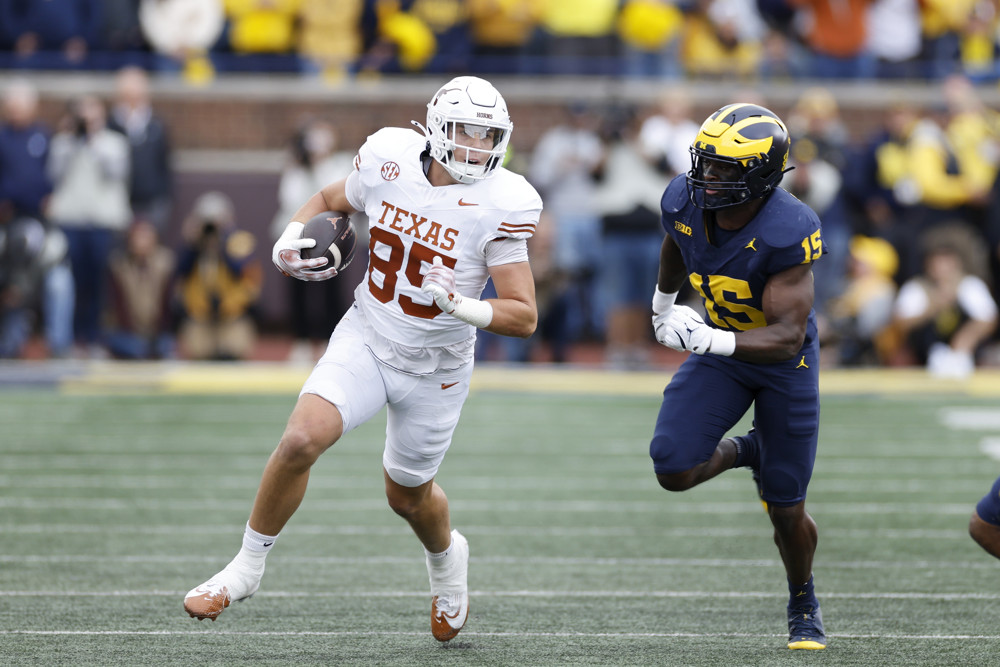
Now, a few years removed from the Denver Broncos selecting Greg Dulcich in the third round of the NFL Draft, it is safe to say that the selection did not pan out as George Paton and the Denver franchise had hoped.
While still a young player, Dulcich has suffered multiple injuries throughout his short career and hasn’t seen great production when on the field, leading to the former Bruin being marked as a healthy scratch each of the past three weeks, and leaving the team with a huge hole at tight end.
With that in mind, the team must start looking elsewhere to secure Bo Nix a viable option at the position.
Luckily for Nix and the Denver Broncos, the 2025 draft class looks to be extremely strong at tight end, but who should they take? Here are four of the most intriguing options.
Gunnar Helm, University of Texas
The most traditional of the tight ends listed, Helm is experiencing a breakout year for the Texas Longhorns, already nearly doubling his receiving years from the season prior, in half the number of games.
The thing that stands out most when watching Helm is how smooth of an athlete he is for being such a large human being. Listed at 6-foot-5 and 250 pounds, Helm has more than enough speed to push up the seam and, more notably, is very good in and out of cuts.
These tools allow for Helm to be a crisp route-runner and, when paired with his remarkably soft hands, he should be a matchup issue for opposing defenses at the next level.
Helm is also a tough guy to bring down after the catch — showcasing sidestep jukes, hurdles, or just having the size and strength to put his shoulder down to pick up a few extra yards. In fact, more than half of his receiving yards this season have been tallied after the catchpoint.
— Joey Richards (@LTB_Joey) October 20, 2024
While his receiving upside is great, Helm separates himself from the other top tight ends in the 2025 class with his blocking ability.
He has plenty of room to grow here, but Helm is already plenty useful whether he’s helping in pass protection or reaching the second level on a run concept. Last season, in a lesser receiving role, this was even more evident for Helm, as he repeatedly demonstrated his capabilities and exhibited high-effort blocking.
Because of this, he could offer the Denver Broncos a ton of positional versatility, projecting as a quality player when either operating in-line or as a ‘move’ tight end.
Colston Loveland, University of Michigan
A season removed from the Michigan Wolverines’ magical national championship run, Loveland is currently in one of the worst passing situations one could imagine. Yet, he is still finding a way to flash his talents all over the film.
While Helm is a smooth athlete for his size, Loveland takes it to a different level, legitimately showcasing a skillset not too far removed from that of a wide receiver.
Simply elite when cutting in and out of his breaks, especially for a player at his position, Loveland is a fantastic separator and gets open with ease. Thankfully, Michigan showcases his rare movement ability as well, as Loveland already has an expansive route tree for a collegiate tight end.
#Michigan TE Colston Loveland (# 18). 6’5 245.
— Kyron Samuels (@kyronsamuels) June 11, 2024
Zero wasted movement in route running. Rare acceleration & deceleration ability. Space eater & grass finder. Alignment versatility. Plus blocker on the perimeter. TE1. pic.twitter.com/9rCffAZtJk
Loveland’s route-running prowess, paired with a strong ability to find the soft spot between coverage zones makes him a genuine pass-catching threat at the next level.
Although he’s a great receiver, Loveland is a thinner-framed prospect and isn’t the greatest blocker as a result. He demonstrates plenty of effort as a blocker, but still, his most natural role in the NFL is to play as a move tight end or as a big slot considering his receiving talents and blocking limitations.
For some teams, this may be an issue as coaches could opt to play a more explosive wide receiver in his place, but if paired in the right system, Loveland can be a very efficient player in the NFL. Considering Sean Payton’s initial interest in Greg Dulcich, and past usage of Jimmy Graham, he could offer that perfect pairing.
Tyler Warren, Penn State University
One of the most fun players to study in this class is Tyler Warren. He is fairly new to the tight end position but he is already seeing ridiculous production, as he has gained yardage as a receiver, rusher, and passer through the first chunk of the season.
Warren is used literally all over the field for the Nittany Lions, making it clear that the objective is to get him the ball at any cost, even if that means asking him to snap the football.
Penn State TE Tyler Warren vs. USC
— Jordan Reid (@Jordan_Reid) October 13, 2024
17 catches, 224 yards and a TD.
Checkout the insane play design on his TD catch. He actually started the play at center. pic.twitter.com/jU1E1hFktq
The reason for this is clear — Warren is fantastic with the ball in his hands.
Boasting a massive frame at 6-foot-6 and 260 pounds, he has freaky speed for a player his size, which makes him a tremendous athlete and extremely tough to tackle in space.
One of the ways he’s grown the most at his new position this season is his sure-handedness. In 2023, he dropped six passes which was good for 9.2% of targets. Through the first six games of 2024, Warren has just one drop and a drop rate of 2.4%.
Warren has also made a series of difficult receptions this season, whether it be through contact or one-handed down the field.
As a route runner, Warren can stand to improve, which isn’t surprising considering his background. He doesn’t show much nuance in regard to his separation, often either leaning on pure athletic ability or schemed touches rather than a mastery of leverage or detailed routes.
Thankfully, he’s still new to the position, which theoretically offers a lot of room for development, and there are no athletic limitations standing in the way of him becoming a terrific route-runner.
Much of the same can be said for Warren’s blocking. Currently, he is more of an asset on the move, aligned as an H-back, or schemed to block downfield, rather than dealing with the big defensive lineman in front of him.
Nonetheless, in the NFL, there is no reason to believe that he can’t become a plus blocker once he refines this skill, considering he is such a large and explosive athlete.
Despite his lack of development in some areas, Warren oozes with high-upside potential and a serviceable floor. He makes a solid case to be the top tight end in the upcoming NFL Draft and is definitely a target to watch for the Denver Broncos.
Harold Fannin Jr., Bowling Green
Although this list is littered with players from some of the most prominent football powers in the nation, the best tight end in the country might belong to a smaller, lesser-known program — the Bowling Green Falcons.
Bowling Green tight end Harold Fannin Jr., doesn’t have the same opportunities to match up against elite competition as some of the other great tight ends in this class, but when he does, he produces at an extremely high level.
In fact, in this current season, he has matched up against Penn State and Texas A&M and, across those contests combined, has snagged 19 receptions for 282 receiving yards.
Fannin Jr. achieved this ungodly efficiency by burning the Power-2 defenses with a tremendous amount of explosiveness and speed on his routes, whether galloping downfield or flying underneath on shorter concepts. Specifically, Fannin Jr. is excellent at getting on the toes of his opponent in a hurry, which limits the reaction time afforded to the defender coming out of the break, and, in turn, allows him to separate more easily. Pairing that understanding of how to manipulate coverage players with his outstanding athletic talents makes him an extremely hard guy to cover and a matchup nightmare.
Harold Fannin Jr is the Best TE in CFB. You can see the potential with Fannin.. He has really good route running ability, sudden quickness and playmaking upside. He's currently on pace for 100 catches 1404 yards & 10 TDs. #NFLDraft pic.twitter.com/HaS8PSxl6G
— Sanjit T. (@Sanjit__T) October 15, 2024
This same athleticism shows up once Fannin Jr. gets the ball in his hands. On the season, 495 of Fannin Jr.’s 873 receiving yards have come after the catch, making him one of the nation’s best ball-carriers at his position.
The main concern scouts will have with Fannin Jr. is just how small his frame is.
At only 6-foot-4 and 230 pounds, he offers the same size measurables as Courtland Sutton (6-foot-4, 216) after Thanksgiving Dinner.
Shockingly, this hasn’t negatively affected his blocking thus far, thanks to Fannin Jr. possessing a great deal of effort and core strength. Against the bigger and more athletic defensive linemen he’ll face in the NFL though, this could be a major issue.
Because of those size concerns, it is more than likely Fannin Jr. is more of a move tight end at the next level and a chess piece a smart offensive coordinator will deploy all over the field including H-back and big slot duties.
What Should the Denver Broncos Do?
The Denver Broncos have one of the least productive and overall worst tight end rooms in the league and that must be addressed, whether it be through free agency or the draft.
While young tight ends typically take a longer time to develop than players at other positions, recent examples like Brock Bowers, Sam Laporta, Dalton Kincaid, and Trey McBride show that history may be changing as offensive coaches find ways to make the job less demanding for these extremely talented yet inexperienced prospects.
Because of this, how talented the crop of 2025 rookie tight ends are, and the fact the Denver Broncos need to make multiple moves at the position, George Paton and Sean Payton should place a premium drafting a player at the position.
